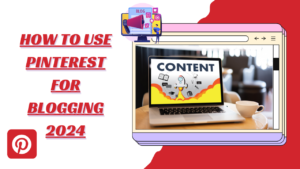
Marketing is arguably one of the most crucial success factors for new online stores and should, therefore, be of paramount importance when launching your e-commerce site. However, if you focus solely on traditional traffic generation strategies and techniques like link building, you’re undoubtedly missing out on a substantial number of potential customers.
The strategies that follow can easily help you create more traffic for your website – and even double it – without “touching” marketing. Here’s how:
Add Long-Tail Variations to Your Pages
It’s easy to concentrate on short terms with very high search volumes since they are easier to identify and research. However, in reality, between 80% and 90% of the traffic you’ll receive will likely come from long-tail search terms, consisting of three, four, or five words, or even more.
It’s often easier to rank well for long-tail keywords, and your conversion rate will be much better than with shorter and generic keywords. Here’s how you can target more long-tail variations and generate more traffic:
Identify “Long-Tail Modifiers”
Suppose we sell the Logitech C310 webcam and want to optimize our page to rank for as many searches as possible. In that case, we would use the Google Keyword Tool to create a list of long-tail variations.
We’d also look at the bottom of the search results page, where Google lists related searches. The related searches for the term “Logitech C310” appear as follows:
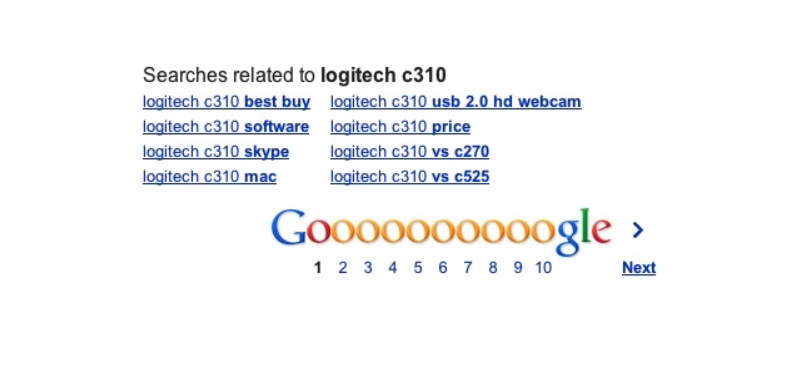
Incorporate These Modifiers into Your Page
Content Since the page created for the Logitech C310 product will likely have been optimized for the term “Logitech C310,” we won’t need to insert every long-tail search phrase textually into the page. Instead, we’ll only insert unique variations located following the term “Logitech C310” into our content to have a chance to rank for these long-tail keywords.
By revisiting related searches, we can identify the words and phrases (highlighted in red below) that should appear on our page:
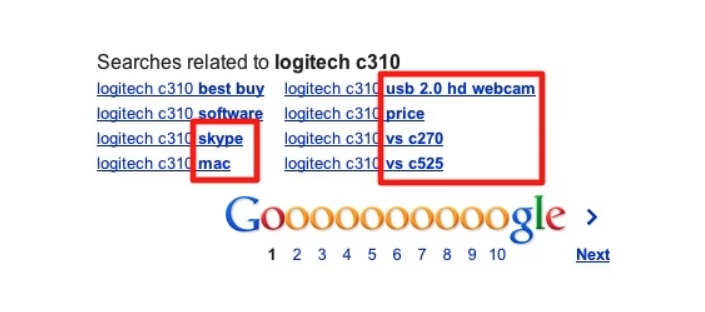
We would add words like “Skype” and “Mac” to our page and discuss differences with the C525 model using the phrase “vs c525.” With these new modifiers included in the content, our page can rank for many searches.
However, we won’t be able to use all the modifiers we discovered. Keywords referring to brands—like “best buy” above—won’t be helpful, and we’ll likely find that our page already contains some long-tail variations that have already been naturally incorporated. Nonetheless, we’ll often discover a handful of very valuable long-tail keywords that will help us rank for more terms and increase our traffic.
Stand Out with Rich Snippets
Rich snippets are search results that include information about the product price, availability, and the average rating given by customers. They are very useful for learning more about the product or site by simply glancing at the search results without visiting the site.
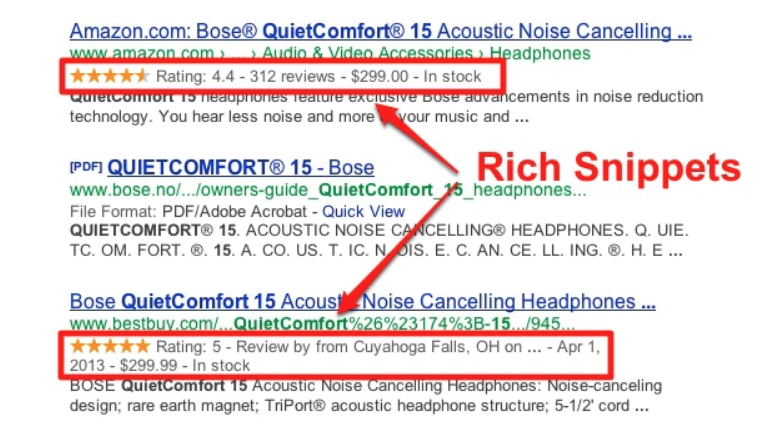
Rich snippets are potent as they can increase page clicks by more than 30%. This is a significant increase, considering how easy it is to implement. Compare this to increasing your marketing budget or ad spend by 30%, and you’ll see why it’s powerful.
The process to set up rich snippets will vary based on your platform, so you might need to do some research before implementing them. Once you think everything is ready, you can use Google’s Structured Data Testing Tool to ensure there are no display issues. Rich snippets might take some time to appear in search results, so don’t worry if you don’t see them immediately.
Google Authorship and Video Thumbnails
Product-related rich snippets are likely to be most useful for many merchants, but there are two other types of enhanced results to be aware of: Google Authorship and video thumbnails.
Through authorship, you can show Google the content you’ve written, and your picture will appear next to your ad in the search results. As the name suggests, a video thumbnail is a miniature of an embedded video on a page, appearing alongside the page’s ad. Like product-related rich snippets, video thumbnails also increase click-through rates for associated pages.
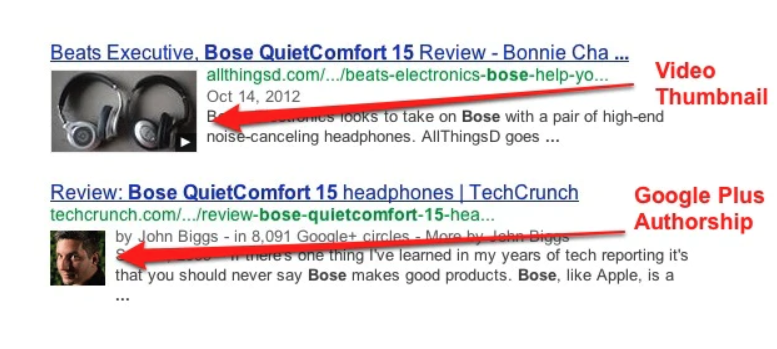
So, what should you use? It depends on your content, products, and goals. Google Authorship might be a great choice to highlight blog articles from a store in search results, while video thumbnails could potentially help showcase educational pages with many videos.
We even notice now that Google Authorship and rich snippets can appear in a single search result:

To have video thumbnails appear, you’ll need to create a video sitemap for Google. You can do this manually through your Webmaster Tools account, and some services like Wistia (love those guys!) will do it automatically for you. For more details on SEO optimization for video and thumbnails, check out this Wistia video.
Craft Irresistible Titles and Descriptions
The meta title and meta description are attributes determining how your pages will appear in search results—and they are crucial. Write a catchy title and an engaging description, and you’ll see it helps highlight your site in search results. If your content is dull and fails to provide a good reason for users to click, you’ll generate less traffic.
In the search results below, I’ve tried to highlight the homepage of my tow engines store by emphasizing the following:
- We exclusively offer high-end tow engines.
- We provide free shipping.
- We do not charge sales tax.
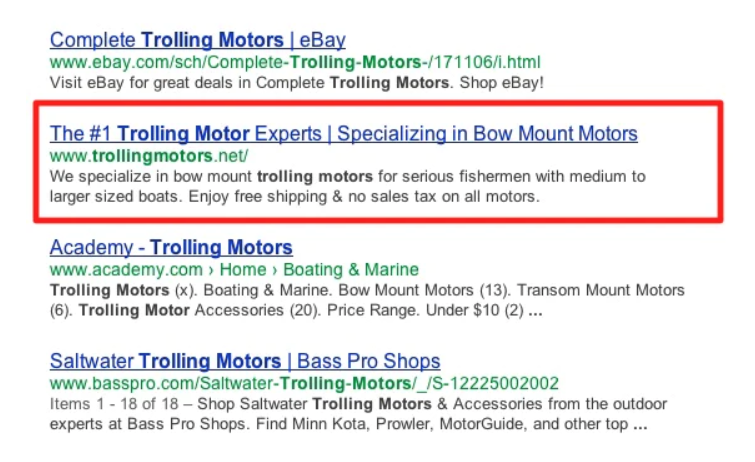
Even though we’re competing with major rivals, I’d wager that our ads receive a higher click-through rate than other pages since many of them aren’t very sales-oriented or persuasive in their copywriting.
When writing meta-titles and meta-descriptions, you need to approach it as if you were writing an advertisement—because you are! Showcase your expertise, unique selling proposition, and reasons why customers should buy from you.
You should also keep SEO and keyword optimization in mind, but don’t overdo it. Include your primary keyword (or keywords) at least once in the title and description, ensuring it appears naturally in your content. But when in doubt, prioritize readability over SEO.
Replacing titles and descriptions with compelling content can have a significant and quick impact on the traffic you receive.
Leverage Internal Links
Getting backlinks from other sites is, of course, an essential and well-known technique. However, not many people understand the influence that site structure and internal links have on your rankings. Want to improve the SEO of a particular page? Pointing links to that page from high-authority pages can pass authority to your target page and help it rank better.
Here’s what you can do:
- Make a list of the most important pages you want to rank better.
- Identify the pages on your website that currently have the most authority and SEO “juice.”
- Add a link from your high-authority page(s) that points to your target page(s).
- Embed the link naturally on the authority page using anchor text linked to the keyword for which you want your target page to rank.
A site’s homepage typically has the most authority in a domain, so choosing the homepage to place links that point to your other pages seems like an obvious choice. To find other high-authority pages, use Open Site Explorer to analyze your internal pages and then sort them by authority in descending order so that the most authoritative page appears at the top.
The techniques we’ve presented are just the tip of the iceberg when it comes to the changes and improvements you can make to your internal linking. For more information on internal linking, check out these articles by HubSpot and SEOMoz.
The Power of Optimization
It might take you years to double your traffic if you only increase the number of backlinks pointing to your site. By using the techniques mentioned above, you’ll be able to significantly increase your traffic by making strategic adjustments to your existing site—and in much less time.

